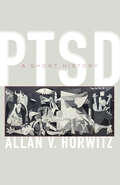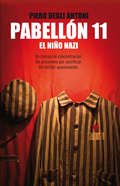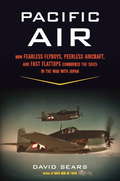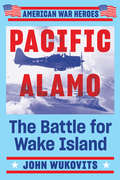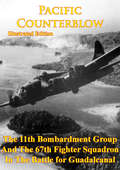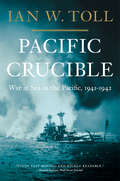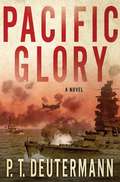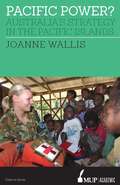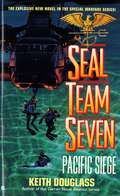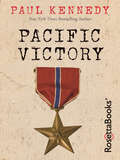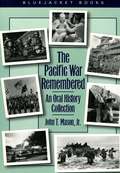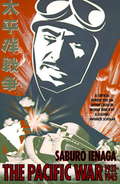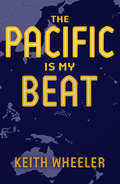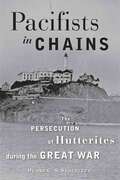- Table View
- List View
PTSD: A Short History (Johns Hopkins Biographies of Disease)
by Allan V. HorwitzA comprehensive history of PTSD.Post-traumatic stress disorder—and its predecessor diagnoses, including soldier’s heart, railroad spine, and shell shock—was recognized as a psychiatric disorder in the latter part of the nineteenth century. The psychic impacts of train crashes, wars, and sexual shocks among children first drew psychiatric attention. Later, enormous numbers of soldiers suffering from battlefield traumas returned from the world wars. It was not until the 1980s that PTSD became a formal diagnosis, in part to recognize the intense psychic suffering of Vietnam War veterans and women with trauma-related personality disorders. PTSD now occupies a dominant place in not only the mental health professions but also major social institutions and mainstream culture, making it the signature mental disorder of the early twenty-first century. In PTSD, Allan V. Horwitz traces the fluctuations in definitions of and responses to traumatic psychic conditions. Arguing that PTSD, perhaps more than any other diagnostic category, is a lens for showing major historical changes in conceptions of mental illness, he surveys the conditions most likely to produce traumas, the results of those traumas, and how to evaluate the claims of trauma victims. Illuminating a number of central issues about psychic disturbances more generally—including the relative importance of external stressors and internal vulnerabilities in causing mental illness, the benefits and costs of mental illness labels, and the influence of gender on expressions of mental disturbance—PTSD is a compact yet comprehensive survey. The book will appeal to diverse audiences, including the educated public, students across the psychological and social sciences, and trauma victims who are interested in socio-historical approaches to their condition.Praise for Allan V. Horwitz’s Anxiety: A Short History"The definitive overview of the history of anxiety."—Bulletin of the History of Medicine"A lucid, erudite and brisk intellectual history driven by a clear and persuasive central argument."—Social History of Medicine"An enlightening tour of anxiety, set at a sensible pace, with an exceptional scholar and writer leading the way."—Library Journal
Pabellón 11: Un campo de concentración. Un prisionero por sacrificar. Un thriller apasionante
by Piero Degli Antoni,Una palabra puede transportar al pasado... Un original thriller psicológico, una macabra partida por la supervivencia en un campo de concentración. Mützen ab! Dos simples palabras pueden transportar al pasado. Eso es lo que sintió Moshe cuando volvió a escucharlas muchos años después. Sintió el frío de Auschwitz, el terror de la voz de los oficiales y el olor fétido de la muerte. Auschwitz, 1944. Debido a la fuga de unos prisioneros y como castigo ejemplar para el resto, diez personas son recluidas en una celda del pabellón 11 para ser asesinadas al día siguiente. Pero un repentino cambio de decisión por parte del Kommandant altera los planes: solo morirá uno, pero serán ellos mismos los que decidan quién. Comienza así una lucha encarnizada en la que valorar quién merece vivir y quién merece morir no resulta tan sencillo como en un principio parecía. En el otro lado del campo, el Kommandant ve cada vez más claro que la guerra está llegando a un final trágico, y se pasa la noche jugando con su hijo una partida de ajedrez que resulta ser un terrible espejo de la realidad. La lucha por la supervivencia y la parcialidad de la bondad y la maldad del hombre componen el engranaje de este thriller psicológico apasionante a la vez que profundamente humano. Reseñas:«Es un libro que me conmovió».Nedo Fiano, superviviente de Auschwitz-Birkenau «Uno de los mejores escritores de thriller de Italia».Il Mattino «Una lectura magnífica y poderosa, alejada del sensacionalismo».Sole 24 Ore «Una novela sobre el bien y el mal, el horror y la esperanza, el destino, la fuerza de voluntad y los lados inesperados de la naturaleza humana. [...] Degli Antoni es un auténtico maestro retratando personajes en todo su dramatismo, sin estereotipos ni clichés. Un feroz juego de eliminación, entre revelaciones y sorpresas,en los tristes barracones. Igual de absorbente que Diez negritos. Piero Degli Antoni enfatiza lo que describe a la perfección Primo Levi: pocos fueron verdaderamente inocentes en los campos de concentración, en donde la supervivencia se lograba a expensas de los más débiles».Il Giorno Milano «Para leerlo de una sentada, con el ritmo de un thriller pese a la triste realidad».Corriere della Sera «Con un final hermoso, una prosa que invita a leer, es una novela diferente porque muestra un equilibrio entre el drama y el thriller».Pasión Romántica
Pacific Air: How Fearless Flyboys, Peerless Aircraft, and Fast Flattops Conquered the Skies in the War with Japan
by David SearsIn a grand sweeping narrative, Pacific Air tells the inspiring story of how, despite initial disastrous defeats, a generation of young naval aviators challenged and ultimately vanquished a superior Japanese air force and fleet in the Pacific. The instruments of the United States aviators' triumphs were the elegantly designed F4F Wildcat, F6F Hellcat, as well as the lethal TBF Avenger torpedo bomber. With superbly trained U.S. Navy and Marine Corps aviators at their controls, these planes became the most successful aerial weapons in naval history.A majestic portrait of a proud era from dual perspectives--the inventive minds of young aeronautical engineers and the deadly artistry of even younger combat pilots--Pacific Air brings this important yet underappreciated chapter of World War II vividly to life.
Pacific Alamo: The Battle for Wake Island
by John WukovitsIt happened in the shadow of Pearl Harbor-mere hours after the first attack on the day that would "live in infamy. " But few know the full story of Wake Island. Now a prominent military historian, breaking new ground on the assault, relates the compelling events of that day and the heroic struggle that followed. Thanks to the brave Marines stationed there-and the civilian construction workers who selflessly put their lives on the line to defend the island-what was supposed to be an easy victory became a protracted and costly battle for Imperial Japan. This is the story of that battle, from survivors on both sides, and with a gallery of historic photos. .
Pacific Battle Line
by Foster Hailey“This book is an attempt to correlate the first two years of the Pacific war, to put events in their proper “Much of the material contained was gathered firsthand, as a correspondent for the New York Times, at sea and ashore with the navy, the marines, and the army, from Christmas Day, 1941, to the conclusion of the Aleutian campaign in August, 1943.“Where events portrayed were not actually participated in, the information has been gleaned from official records or from conversations with the men who took part in them.“No effort has been made to present this war as anything but what it is, the ultimate insanity of civilization. All of war is hard work, much of it is boring, a fact to which any man will attest who has taken part in one. But the exigencies of war also bring out in many men traits you would not know they had—patience under pressure, cheerfulness under great difficulty, stoicism under pain, raw courage in the face of terrible danger. An effort has been made to tell that too.“Here then is the record as one reporter saw it, a record written in blood and sweat, of the first two years of the wax in the Pacific.“There are many reasons, of course, for writing a book. The principal reason for writing this one is this: that the men with whom I shared some of the hardships and some of the dangers deserve to have their story told, and told as objectively and factually as I can tell it. If they believe that I have made an honest effort to do that and have achieved some success, that will be satisfaction enough for ‘the correspondent from the Times.’”
Pacific Counterblow - The 11th Bombardment Group And The 67th Fighter Squadron In The Battle For Guadalcanal: [Illustrated Edition] (Wings at War #3)
by Anon[Illustrated with 6 photos and 3 maps]Originally published shortly after key air campaigns, the Wings at War series captures the spirit and tone of America's World War II experience. Eyewitness accounts of Army Air Forces' aviators and details from the official histories enliven the story behind each of six important AAF operations.Pacific Counterblow tells the story of the Battle for Guadalcanal (1942), focusing on the operations of the 11th Bombardment Group and the 67th Fighter Squadron.Months after the devastation of Pearl Harbor, U.S. forces had crushed the Japanese fleet at Midway and then moved to seize the initiative. AAF commanders in the Pacific sought to prevent the enemy from severing Australia's supply lines. So the B-17s of the 11th Bomb Group and the P-39s and P-400s of the 67th Fighter Squadron, flying from makeshift bases at Espiritu Santo and Henderson Field, began grueling attacks on Japanese shipping between Rabaul, New Britain and the Solomon Islands. After several months of bitter fighting, American forces gained control of Guadalcanal, positioning them to swing forward beyond Rabaul to New Guinea.
Pacific Crucible: War at Sea in the Pacific, 1941-1942 (The Pacific War Trilogy #1)
by Ian W. Toll"Both a serious work of history . . . and a marvelously readable dramatic narrative."--San Francisco Chronicle On the first Sunday in December 1941, an armada of Japanese warplanes appeared suddenly over Pearl Harbor, Hawaii, and devastated the U.S. Pacific Fleet. Six months later, in a sea fight north of the tiny atoll of Midway, four Japanese aircraft carriers were sent into the abyss, a blow that destroyed the offensive power of their fleet. Pacific Crucible tells the epic tale of these first searing months of the Pacific war, when the U.S. Navy shook off the worst defeat in American military history and seized the strategic initiative. This dramatic narrative, relying predominantly on eyewitness accounts and primary sources, is laced with riveting details of heroism and sacrifice on the stricken ships and planes of both navies. At the war's outset, Japan's pilots and planes enjoyed a clear-cut superiority to their American counterparts, but there was a price to be paid. Japanese pilots endured a lengthy and grueling training in which they were disciplined with baseball bats, often suffering broken bones; and the production line of the Zero-- Japan's superbly maneuverable fighter plane--ended not at a highway or railhead but at a rice paddy, through which the planes were then hauled on ox carts. Combat losses, of either pilots or planes, could not be replaced in time to match the fully mobilized American war machine. Pacific Crucible also spotlights recent scholarship that revises our understanding of the conflict, including the Japanese decision to provoke a war that few in their highest circles thought they could win. Those doubters included the flamboyantly brilliant Admiral Isokoru Yamamoto, architect of the raid on Pearl and the Midway offensive. Once again, Ian W. Toll proves himself to be a simply magnificent writer. The result here is a page-turning history that does justice to the breadth and depth of a tremendous subject.
Pacific Glory: A Novel
by P. T. DeutermannMarsh Vincent, Mick McCarty, and Tommy Lewis were inseparable friends during their naval academy years, each man in love with the beautiful, unattainable Glory Hawthorne. Only Tommy wins her heart and marries Glory after graduation. Different skills set the three men on separate paths in the Navy, but they are all forever changed by the Pearl Harbor attack on December 7,1941. Glory, now Tommy's widow, is a tough Navy nurse still grieving her loss while trying to save lives at the Pearl Harbor naval hospital. Marsh, a surface ship officer, finds himself in the thick of terrifying sea combat from Guadalcanal, through the turning point at Midway, to a climactic showdown with the Japanese fleet at Leyte Gulf. Mick, a hotshot fighter pilot with a drinking problem and a chip on his shoulder, seeks redemption after a series of failures leaves him grounded and ashamed. Filled with wide-screen action, romance, and heroism tinged with the brutal reality of war, Pacific Glory is an old-fashioned military adventure of the first order.
Pacific Interlude: A Novel
by Sloan WilsonDuring the last days of World War II, a young officer braves enemy fire and a maverick crew on the open waters and in the steamy ports of the South Pacific Twenty-five-year-old Coast Guard lieutenant Sylvester Grant, a veteran of the Greenland Patrol, has just been given command of a small gas tanker, running shuttle and convoy duties for the US Army. Sally, his wife of three years, is eager for him to get back to Massachusetts and live a conventional suburban life selling insurance--but Syl longs for adventure and is bound to find it as the captain of a beat-up, unseaworthy vessel carrying extremely flammable cargo across dangerous stretches of the Pacific Ocean. As the Allies prepare to retake the Philippines, the only thing the sailors aboard the Y-18 want is for the war to be over. First, however, they must survive their mission to bring two hundred thousand gallons of high-octane aviation fuel to shore. From below-deck personality clashes to the terrifying possibility of an enemy attack, from combating illness and boredom to the constant stress of preventing an explosion that could blow their ship sky high, the crew of the Y-18 must learn to work together and trust their captain--otherwise, they might never make it home. Based on Sloan Wilson's own experiences, Pacific Interlude is a thrilling and realistic story of World War II and a moving portrait of a man looking toward the future while trying to survive a precarious present.
Pacific Onslaught: 7th Dec. 1941/7th Feb. 1943 (The\pan/ballantine Illustrated History Of World War 2 Ser.)
by Paul KennedyA look at the early years of the Pacific conflict in World War II, by the New York Times–bestselling author of The Rise and Fall of the Great Powers. Japan had mighty ambitions: to control the Western Pacific. The attack on Pearl Harbor devastated their primary obstacle—the American Pacific fleet—and they swept across the region. What ensued was a bitter struggle in which many thousands of soldiers lost their lives on both sides. This is the first book in Paul Kennedy&’s chronicle of the Pacific conflict in World War II, concluded in Pacific Victory. Featuring a new introduction by the author, this book provides a close, step-by-step narrative of the Japanese expansion into the Western Pacific during some of the most brutal years of World War II. Offering contemporary analysis of war strategy, it includes a riveting look at Japan&’s tightening grip on Hong Kong, New Guinea, the Philippines, and other key strategic locations—and the Allies&’ inexorable struggle against it.
Pacific Payback: The Carrier Aviators Who Avenged Pearl Harbor at the Battle of Midway
by Stephen L. Moore&“Deeply researched and well written....By far the most detailed account of USS Enterprise&’s dive-bombers and their decisive role at the Battle of Midway.&”*Sunday, December 7, 1941, dawned clear and bright over the Pacific.... But for the Dauntless dive-bomber crews of the USS Enterprise returning to their home base on Oahu, it was a morning from hell. Flying directly into the Japanese ambush at Pearl Harbor, they lost a third of their squadron and witnessed the heart of America&’s Navy broken and smoldering on the oil-slicked waters below. The next six months, from Pearl Harbor to the Battle of Midway—a dark time during which the Japanese scored victory after victory—this small band of aviators saw almost constant deployment, intense carrier combat, and fearsome casualties. Many were killed by enemy Zero fighters, antiaircraft fire, or deadly crash landings in the Pacific, while others were captured and spent years in POW camps. Yet the Enterprise&’s Dauntless crews would be the first to strike an offensive blow against Japanese installations in the Marshall Islands, would be the first to sink a Japanese warship, and would shepherd the Doolittle Raiders&’ bombing of Tokyo. Not until Midway, though, would Dauntless crews get the chance to settle the score...and change the course of World War II. Drawing on dozens of new interviews and oral histories, author Stephen L. Moore brings to life inspiring stories of individual sacrifice and bravery—and the sweeping saga of one of America&’s greatest triumphs. INCLUDES PHOTOS
Pacific Power?: Australia's strategy in the Pacific Islands
by Joanne WallisAustralia is much larger and has significantly more military and economic power than its Pacific Island neighbours. As a result, it is frequently described as having a natural right to lead in the region. Yet, Australia has found it difficult to effectively influence Pacific Island states in pursuit of its strategic interests. It provides the definitive account of how, and how effectively, Australia has sought to influence Pacific Island states in pursuit of its strategic interests since 1975, the year that Papua New Guinea, Australia's former colonial territory, gained independence. Informed by interviews with key decision makers, Pacific Power? analyses why Australia has had difficulty exercising influence in the Pacific Islands and identifies how Australia can more effectively influence Pacific Island states in pursuit of its strategic interests, and how Australia can present itself more as a Pacific partner than power.
Pacific Siege (Seal Team Seven #8)
by Keith DouglassAction! Intrigue! Firepower! When a Japanese general goes ballistic and takes over a Russian island, the SEALs are sent in to restore justice. But between freeing Russian hostages and making sure not to step on the wrong toes, the SEALs find themselves stuck waist-deep in hell--and high water. Book Quality: Excellent
Pacific Skies: American Flyers in World War II
by Jerome KlinkowitzFrom 1941 to 1945 the skies over the Pacific Ocean afforded the broadest arena for battle and the fiercest action of air combat during World War II. It was in the air above the Pacific that America's involvement in the war began. It was in these skies that air power launched from carriers became a new form of engagement and where the war ultimately ended with kamikaze attacks and with atomic bombs dropped over Japan. Throughout the conflict American flyers felt a compelling call to supplement the official news and military reports. In vivid accounts written soon after combat and in reflective memoirs recorded in the years after peace came, both pilots and crew members detailed their stories of the action that occurred in the embattled skies. Their first-person testimonies describe a style of warfare invented at the moment of need and at a time when the outcome was anything but certain. Gathering more than a hundred personal narratives from Americans and from Japanese, Pacific Skies recounts a history of air combat in the Pacific theater. Included are the words of such famous aces and bomber pilots as Joe Foss, Pappy Boyington, Dick Bong, and Curtis Lemay, as well as the words of many rank-and-file airmen. Together their stories express fierce individualism and resourcefulness and convey the vast panorama of war that included the skies over Pearl Harbor, Wake, and Guadalcanal and missions from Saipan and Tinian. As Pacific Skies recounts the perilous lives of pilots in their own words, Jerome Klinkowitz weaves the individual stories into a gripping historical narrative that exposes the shades of truth and fiction that can become blurred over time. A book about experiencing and remembering, Pacific Skies also is a story of unique perspectives on the war.
Pacific Victory
by Paul KennedyA look at the events leading up to Japan&’s surrender in World War II, from the New York Times–bestselling author of Engineers of Victory. By the spring of 1943, Japan had a tight grip on the countries and territories of East Asia and the Western Pacific. But the Allies had won decisive victories at Midway and Guadalcanal, and they were coming for the rest of Japan&’s conquests. Now the empire of Japan would be on the defensive. Featuring a new introduction by the author, this book picks up where Pacific Onslaught left off, providing a detailed, step-by-step account of the Allies&’ unstoppable rally across territories annexed by the Japanese in a brutal two-pronged attack across New Guinea and the Philippines, and the islands of the central Pacific. Here you&’ll find detailed contemporary accounts and strategy, from the epic battles of the Gilberts and Marshalls to the dropping of the atomic bombs on Hiroshima and Nagasaki and Japan&’s final surrender on the decks of the USS Missouri.
Pacific War Remembered
by John T. Mason Jr.In this remarkable oral history collection, thirty-three participants in the turbulent epic that began with the day of infamy at Pearl Harbor and ended with the signing of the surrender documents in Tokyo Harbor tell their stories. Their remembrances of heartbreak, frustration, heroism, hope, and triumph were collected over a period of twenty-five years by John T. Mason. Their recollections reveal perspectives and facts not included in traditional works of history. Each selection, introduced with a preface that places it in the context of the Pacific War, takes the reader behind the scenes to present the personal, untold stories of naval history.Included are Admiral William S. Sullivan's account of the problems involved in clearing Manila Harbor of some five hundred wrecked vessels left by the departing Japanese and Admiral Thomas C. Kinkaid's description of the communications breakdown at the Battle of Leyte Gulf. There are also the very personal recollections of humor and horror told by the unknown actors in the war: the hospital corpsman, the coxswain, and the machinist's mate. Originally published in 1986, this volume is an unusual and lasting tribute to the ingenuity and teamwork demonstrated by America's forces in the Pacific as well as a celebration of the human spirit
Pacific War, 1931-1945
by Saburo IenagaA portrayal of how and why Japan waged war from 1931-1945 and what life was like for the Japanese people in a society engaged in total war.From the Trade Paperback edition.
Pacific is my Beat
by Keith WheelerThe Pacific is My Beat, first published in 1943, is war correspondent Keith Wheeler's front-line account of his experiences with the U.S. Army and Navy during the Second World War following the attack on Pearl Harbor. After a brief stint in the Marshall Islands, Wheeler travels to the Aleutian Islands where he vividly describes an oft-forgotten slice of the war, but one characterized by extreme, difficult weather, sodden living conditions, and an enemy that had no plans to surrender, but instead chose to fight to their death or commit mass-suicide with grenades. Wheeler was a gifted writer whose stories appeared on newspapers nationwide. He painted an accurate picture of war-time life for American soldiers, sailors, and aviators. This new kindle edition includes 33 pages of maps and photographs.
Pacification (Indochina Monographs #10)
by Brig. Gen. Tran Dinh ThoIncludes over 30 maps and illustrationsThis monograph forms part of the Indochina Monograph series written by senior military personnel from the former Army of the Republic of Vietnam who served against the northern communist invasion.Pacification is the military, political, economic, and social process of establishing or re-establishing local government responsive to and involving the participation of the people. It includes the provision of sustained, credible territorial security, the destruction of the enemy's underground government, the assertion or re-assertion of political control and involvement of the people in government, and the initiation of economic and social activity capable of self-sustenance and expansion.Defined as such, pacification is a broad and complex strategic concept which encompasses many fields of national endeavor. As a program implemented jointly with the U.S. military effort in South Vietnam, pacification appears to have involved every American serviceman and civilian who served there, many of whom indeed participated in conceiving the idea and helping put it to work.In the attempt to present every relevant aspect of the GVN pacification effort, I have mostly relied on my personal experience as one of the many architects who helped draw part of the blueprint and oversaw its progress, and complemented it by conducting interviews with responsible officials and studying available documentation.
Pacifists in Chains: The Persecution of Hutterites during the Great War (Young Center Books in Anabaptist and Pietist Studies)
by Duane C. StoltzfusDocuments the disturbing history of four pacifists imprisoned for their refusal to serve during World War I.To Hutterites and members of other pacifist sects, serving the military in any way goes against the biblical commandment "thou shalt not kill" and Jesus’s admonition to turn the other cheek when confronted with violence. Pacifists in Chains tells the story of four young men—Joseph Hofer, Michael Hofer, David Hofer, and Jacob Wipf—who followed these beliefs and refused to perform military service in World War I. The men paid a steep price for their resistance, imprisoned in Alcatraz and Fort Leavenworth, where the two youngest died. The Hutterites buried the men as martyrs, citing mistreatment.Using archival material, letters from the four men and others imprisoned during the war, and interviews with their descendants, Duane C. S. Stoltzfus explores the tension between a country preparing to enter into a world war and a people whose history of martyrdom for their pacifist beliefs goes back to their sixteenth-century Reformation beginnings.
Pack Carla Montero con: El medallón de fuego | La tabla esmeralda
by Carla MonteroEdición estuche de lujo que reúne dos grandes novelas de Carla Montero. La tabla esmeralda Madrid, en la actualidad: hasta que El Astrólogo se cruzó en su camino, Ana, una joven historiadora del arte del Museo del Prado, llevaba una vida tranquila junto a Konrad, un rico empresario y coleccionista de arte alemán. Pero de repente llega a sus manos una carta escrita durante la Segunda Guerra Mundial que los pone sobre la pista del misterioso cuadro atribuido a Giorgione, el enigmático pintor del Renacimiento. Alentado por el enorme valor de El Astrólogo, Konrad convence a Ana para embarcarse en su búsqueda. La joven, consciente de todas las dificultades que se le presentan, pedirá ayuda al doctor Alain Arnoux de la Universidad de la Sorbona, especialista en localizar obras de arte expoliadas por los nazis. Pero esta decisión solo parece complicarle las cosas. París, durante la ocupación alemana: el comandante de las SS, Georg von Bergheim, militar de élite y héroe de guerra, acaba de recibir una orden: debe encontrar el paradero de un cuadro de Giorgione conocido como El Astrólogo. Hitler está convencido de que la obra esconde un gran enigma, una revelación que ha pasado de mano en mano durante siglos. La búsqueda conduce al comandante hasta la joven judía Sarah Bauer, iniciándose entre ellos una persecución trepidante que tendrá consecuencias totalmente inesperadas para ambos. ______________________________ El medallón de fuego Madrid, en la actualidad: Ana recibe la llamada de Martin, el joven y misterioso buscador de tesoros a quien conoció fugazmente durante la búsqueda de El Astrólogo en La Tabla Esmeralda. Han asesinado a un magnate italiano y un poderoso tesoro está en peligro: el Medallón de Hiram, una reliquia mágica que perteneció al arquitecto del templo de Salomón. Nadie conoce el paradero exacto de la pieza y Martin necesita la ayuda de Ana para encontrarla. Ambos emprenderán una trepidante búsqueda por toda Europa enfrentándose a infinidad de peligros, pues muy pronto descubrirán que ellos no son los únicos que desean hacerse con la reliquia. Berlín, 1945: en los estertores de la Segunda Guerra Mundial, los destinos de cuatro personas están a punto de cruzarse con consecuencias imprevistas para el Medallón de Hiram: un sanguinario nazi que rastrea un Berlín en ruinas con la obsesión de hacerse con el medallón; un joven español, estudiante de arquitectura, que se ve envuelto en una intriga insospechada; un ingeniero alemán que está en el punto de mira del servicio de inteligencia ruso, y una francotiradora del ejército soviético que guarda un importante secreto.
Pack Up Your Troubles: War at Home 6
by Cynthia Harrod-EaglesThe final book in Cynthia's War at Home series'Always a stay-up-all-night read with Cynthia Harrod-Eagles! *****'Fabulous series of books, this author never disappoints' *****'I love Cynthia Harrold-Eagles' historical novels' *****1919: The war is over, but peace is yet to come. As men are demobbed, women must give up positions that gave them freedom. Edward is given an important job at the Peace Conference in Paris, but it means more lonely months away from Beattie and his hoped-for reconciliation. Fred's unit is sent to the Rhine, and Cook feels a guilty relief that her uprooting has been postponed. Laura's friend Ransley volunteers for a further six months, and rather than go home, Laura finds a new outlet: conducting guided tours of the battlefields. In England there are strikes and unrest, hardship and widespread unemployment, and everywhere the sight of the wounded to remind the nation of what it has paid for peace. But as the first, difficult year post-war comes to an end, there are great changes afoot for the Hunter household, wonderful surprises, and the promise of a new start.Pack Up Your Troubles is the sixth and final book in the War at Home series by Cynthia Harrod-Eagles, author of the much-loved Morland Dynasty novels. Set against the real events of 1919, at home and on the front, this concludes the vivid and rich family drama featuring the Hunter family and their servants.
Pack Up Your Troubles: War at Home, 1919 (War at Home #6)
by Cynthia Harrod-EaglesThe brand new series, perfect for fans of DOWNTON ABBEY, from the author of the hugely successful MORLAND DYNASTY novels . . . 1919: The war is over, but peace is yet to come. As men are demobbed, women must give up positions that gave them freedom. Edward is given an important job at the Peace Conference in Paris, but it means more lonely months away from Beattie and his hoped-for reconciliation. Fred's unit is sent to the Rhine, and Cook feels a guilty relief that her uprooting has been postponed. Laura's friend Ransley volunteers for a further six months, and rather than go home, Laura finds a new outlet: conducting guided tours of the battlefields. In England there are strikes and unrest, hardship and widespread unemployment, and everywhere the sight of the wounded to remind the nation of what it has paid for peace. But as the first, difficult year post-war comes to an end, there are great changes afoot for the Hunter household, wonderful surprises, and the promise of a new start.Pack Up Your Troubles is the sixth and final book in the War at Home series by Cynthia Harrod-Eagles, author of the much-loved Morland Dynasty novels. Set against the real events of 1919, at home and on the front, this concludes the vivid and rich family drama featuring the Hunter family and their servants.
Pack Up Your Troubles: War at Home, 1919 (War at Home #6)
by Cynthia Harrod-EaglesThe final book in Cynthia's War at Home series'Always a stay-up-all-night read with Cynthia Harrod-Eagles! *****'Fabulous series of books, this author never disappoints' *****'I love Cynthia Harrold-Eagles' historical novels' *****1919: The war is over, but peace is yet to come. As men are demobbed, women must give up positions that gave them freedom. Edward is given an important job at the Peace Conference in Paris, but it means more lonely months away from Beattie and his hoped-for reconciliation. Fred's unit is sent to the Rhine, and Cook feels a guilty relief that her uprooting has been postponed. Laura's friend Ransley volunteers for a further six months, and rather than go home, Laura finds a new outlet: conducting guided tours of the battlefields. In England there are strikes and unrest, hardship and widespread unemployment, and everywhere the sight of the wounded to remind the nation of what it has paid for peace. But as the first, difficult year post-war comes to an end, there are great changes afoot for the Hunter household, wonderful surprises, and the promise of a new start.Pack Up Your Troubles is the sixth and final book in the War at Home series by Cynthia Harrod-Eagles, author of the much-loved Morland Dynasty novels. Set against the real events of 1919, at home and on the front, this concludes the vivid and rich family drama featuring the Hunter family and their servants.
Pack of Thieves
by Richard Z. ChesnoffIt was the largest organized robbery in history: the systematic looting of Europe's Jews by the Nazis, in cooperation with most of the nations in Europe?Axis, Allied, and neutral. Award--winning journalist Richard Z. Chesnoff, one of the first reporters to break the story that Swiss banks had hoarded the assets of Holocaust victims, traveled to fourteen countries to research this heartbreaking, compelling story of human greed. Through exclusive interviews and information from hitherto classified files, Chesnoff tells a tragic tale, the vast scope of which is only beginning to be known. Revealing new details that many would prefer remained secret, Pack of Thieves describes the detective work used to trace Holocaust assets that continue to be hidden inside the financial systems of such Allied nations as France and the Netherlands. Daring, insightful, and necessary, Pack of Thieves is at once a fascinating piece of investigative journalism and an enraging account of one of history's greatest crimes.From the Trade Paperback edition.
